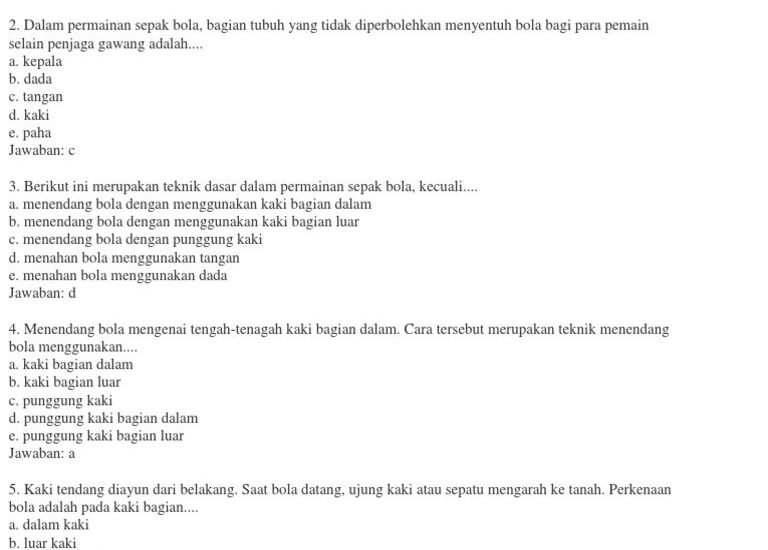In a soccer match, permainan sepak bola terdiri atas babak, and understanding this structure enriches your viewing experience. Each half lasts 45 minutes, separated by a short interval, creating a dynamic flow that keeps players and fans engaged. This format not only tests skill and strategy but also adds an element of drama as teams adapt their tactics throughout the game. Embracing the significance of these halves can deepen your appreciation for the sport and the athletes who play it.
“`html
Permainan Sepak Bola Terdiri Atas Babak: An In-Depth Look
Permainan sepak bola, or football, is one of the most cherished sports worldwide. It attracts millions of fans and players alike. The game is organized into distinct sections known as “babak.” Understanding these segments is essential for anyone wanting to grasp how the game unfolds. This article will provide a detailed exploration of the different babak in sepak bola, including their structure, purpose, and the excitement they bring to both players and spectators.
Understanding the Structure of Babak in Sepak Bola
The game of sepak bola consists of two main halves: the first babak (half) and the second babak. Each half lasts a specific duration, and these periods play a crucial role in the flow of the game.
Duration of Each Babak
– **First Babak**: Typically lasts 45 minutes.
– **Second Babak**: Also lasts 45 minutes.
Together, these halves combine to make a standard football match last 90 minutes. However, extra time and injury time can extend the actual duration of the match.
Halftime Break
Between the two babak, there’s a break known as halftime. This period usually lasts about 15 minutes and offers players a chance to rest and strategize. Coaches often use this time to provide feedback and to make adjustments based on the first half’s performance.
The Importance of Each Babak
Each babak has its significance, impacting the game’s overall dynamics. Let’s take a closer look at each one.
First Babak: Setting the Tone
The first babak is crucial for establishing the tempo of the game. Here’s what happens during this period:
– **Initial Strategy**: Teams tend to showcase their strategies. They test their opponents’ defenses and see how the other team responds to different plays.
– **Goal Scoring Opportunities**: The first babak often includes numerous attempts to score, allowing teams to gauge their effectiveness.
– **Building Momentum**: A strong performance in the first half can build a team’s confidence and momentum heading into the second babak.
Statistics show that the team that scores first often has a better chance of winning the match. This makes the first babak especially critical for setting the psychological tone.
Second Babak: The Fight for Victory
The second babak is where the game’s intensity often ramps up. Players usually return with renewed energy, and the stakes are higher. Here’s what occurs:
– **Adjustments**: Coaches and players make tactical changes based on the first babak’s observations.
– **Increased Pressure**: If one team is trailing, they may become more aggressive, leading to exciting play.
– **Climactic Moments**: This half frequently features dramatic goals, fouls, and even penalties that can change the course of the game.
Many memorable moments in football history occur during the second babak, making it an exhilarating experience for fans.
Extra Time and Penalty Shootouts
If the game ends in a tie after the two babak, the match can lead to extra time and potentially a penalty shootout.
Extra Time
– **Duration**: Extra time consists of two additional 15-minute halves.
– **Purpose**: The aim is to break the tie by allowing teams to compete for a winning goal.
Playing through extra time can be exhausting, as players push themselves beyond the standard 90 minutes.
Penalty Shootouts
If the score remains tied after extra time, penalty shootouts determine the winner. Here’s how it works:
– **Format**: Each team takes turns attempting to score from the penalty mark.
– **Pressure**: The shootout creates a high-pressure situation, as every kick counts.
This stage is often the most nerve-wracking, not only for players but also for fans watching from the stands.
Strategic Changes Through Babak
Coaches often employ different strategies throughout the babak to capitalize on their team’s strengths and weaknesses.
Formation Shifts
During the halftime break, coaches may opt to change formations. Some common formations include:
– **4-4-2**: This balanced formation includes four defenders, four midfielders, and two forwards.
– **4-3-3**: A more attacking style with three forwards and a solid midfield.
– **5-3-2**: This defensive setup can help in preserving a lead.
Coaches analyze the first babak to determine which formation best suits the team’s current situation.
Substitutions
Substitutions can also play a pivotal role. Teams are allowed to substitute players to:
– **Injuries**: Replace injured players who can no longer continue.
– **Fresh Legs**: Bring in players who provide new energy.
– **Tactical Changes**: Shift strategies as the game evolves.
Effective substitutions are often decisive in the outcome of a match.
The Role of Referees and Timekeepers in Each Babak
Referees and timekeepers play critical roles in managing the babak of a football match.
Referee Responsibilities
– **Enforcing Rules**: The referee ensures players adhere to the laws of the game, penalizing fouls and misconduct as needed.
– **Game Flow**: They manage the flow of the game, making decisions that can change the course of play, such as awarding penalties or issuing cards.
The referee’s decisions can significantly impact the match’s momentum and outcome.
Timekeeping**
– **Injury Time**: At the end of each babak, the referee may add extra time for stoppages due to injuries or other delays.
– **Official Time**: The main timekeeper records the start and end of each babak, ensuring the match runs smoothly.
Proper time management is essential for fairness and consistency, creating a balanced playing field.
Fan Experience During Each Babak
The experience for fans can differ greatly between the two babak. Understanding this can enhance one’s appreciation of the sport.
First Babak Excitement
– **Anticipation**: Fans often feel a buzz of excitement as the game kicks off, eager to see how their team will perform.
– **Chants and Cheers**: This half is filled with enthusiastic chants and cheers as fans rally behind their teams.
The atmosphere is electric as everyone awaits the first goal.
Second Babak Drama**
– **Tension**: As the game progresses, the tension ramps up, especially if the score is tight.
– **Last-Minute Thrills**: Fans are on the edge of their seats as they anticipate last-minute goals or pivotal plays.
The second babak often delivers unforgettable moments that become stories for fans to share.
The structure of sepak bola, organized into babak, deeply affects how the game unfolds. By understanding the significance of each half, the strategies employed by coaches, the roles of referees, and the emotional rollercoaster for fans, one can appreciate the depth of this beloved sport. Whether you are a casual observer or a dedicated fan, knowing about the babak will enhance your experience of watching and enjoying the beautiful game of football.
“`
This section provides a complete exploration of the topic, focusing on the structure and importance of each babak in football, while maintaining a conversational tone and ensuring accessibility for a younger audience.
Permainan Sepak Bola Lengkap
Frequently Asked Questions
“`html
What is the duration of each half in a standard soccer match?
A standard soccer match consists of two halves, each lasting 45 minutes. There is typically a halftime interval of about 15 minutes between the two halves. However, the referee can add extra time at the end of each half to account for stoppages in play.
How does the structure of halves impact the strategy of the game?
The structure of two 45-minute halves influences the strategies teams employ. Coaches often plan their tactics based on the time available in each half, considering factors like player stamina and game score. Teams might adopt a more defensive approach in the second half if they are leading, while a trailing team may take more risks to score.
What happens if the match ends in a draw?
If a match ends in a draw, the rules for what happens next depend on the competition format. In knockout tournaments, teams may go into extra time, consisting of two additional 15-minute halves. If the score remains tied after extra time, the match usually proceeds to a penalty shootout to determine the winner.
Are there any breaks during the halves?
While there are no formal breaks during the 45-minute halves, players can receive treatment for injuries at the referee’s discretion. Additionally, the referee will signal for water breaks in extreme weather conditions to ensure players stay hydrated.
Can the duration of the halves change in specific circumstances?
In normal circumstances, the duration of each half remains 45 minutes. However, referees can extend the time for stoppages, known as added or injury time, at the end of each half. In special formats like youth tournaments, the duration of halves may be adjusted according to the age group of the players.
“`
Final Thoughts
Permainan sepak bola terdiri atas babak, dengan setiap babak memberikan kesempatan untuk strategi dan keterampilan yang berbeda. Babak pertama biasanya menonjolkan upaya awal tim untuk menguasai permainan, sementara babak kedua sering kali menunjukkan intensitas yang meningkat.
Pemain dan pelatih harus mampu beradaptasi dengan perubahan ini untuk mencapai kemenangan. Memahami bahwa permainan sepak bola terdiri atas babak membantu semua pihak mengevaluasi performa dan merencanakan langkah selanjutnya.






